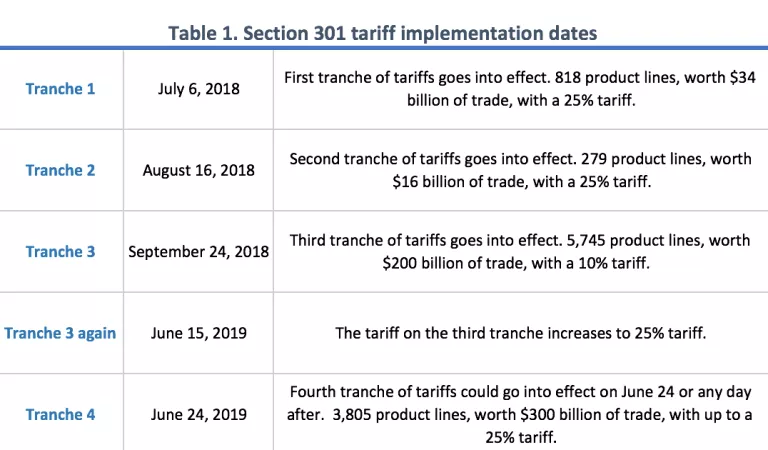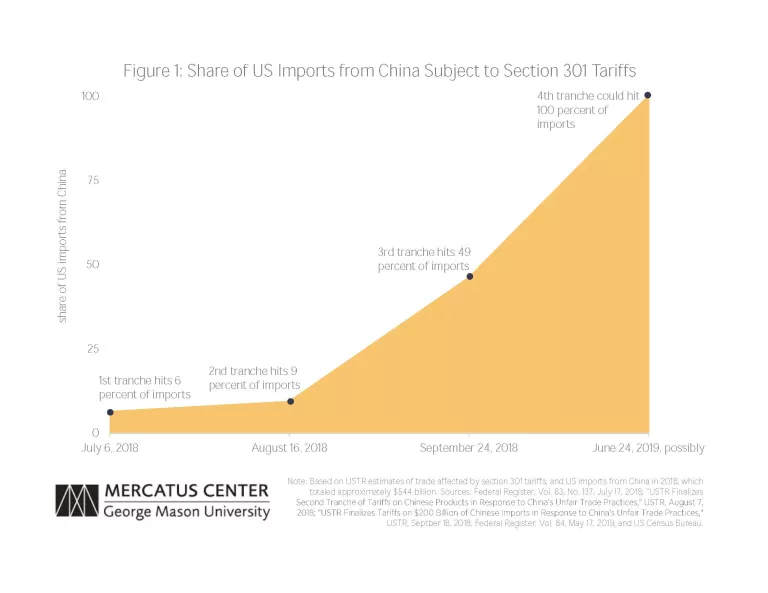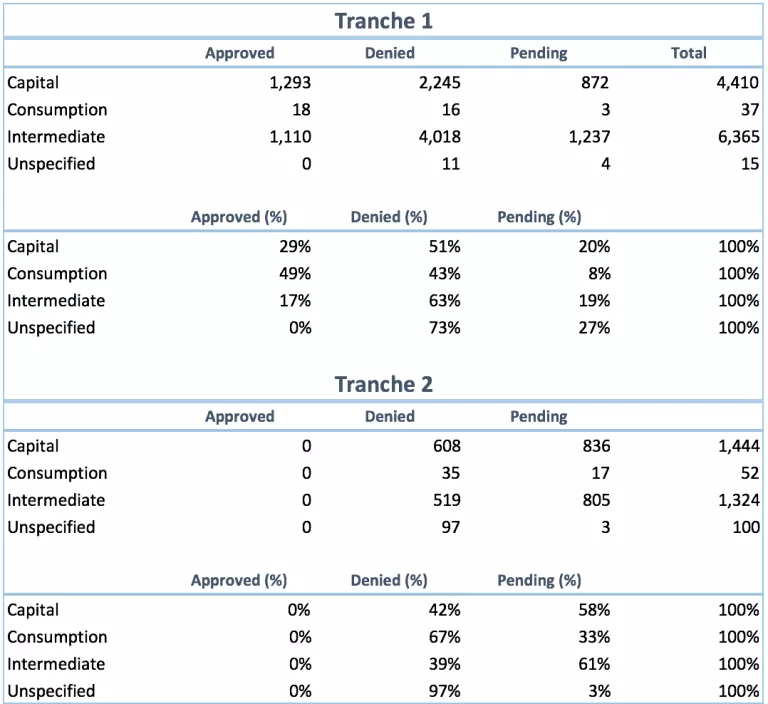- | International Freedom and Trade International Freedom and Trade
- | Expert Commentary Expert Commentary
- |
Investigating Product Exclusion Requests for Section 301 Tariffs
In the US-China trade dispute, tariffs have been one of the more visible weapons of choice. Under Section 301(B) of the Trade Act of 1974 (commonly called “Section 301”), President Trump has authorized tariffs on approximately $250 billion of US imports from China, which represents nearly half of the value of US imports from China in 2018. There have been three tranches of tariffs. The fourth tranche, if implemented, would cover nearly the entire remaining amount of trade. We compile data on Section 301 tariffs and the corresponding requests from US businesses to exclude certain products from the tariffs. The key findings are:
- US businesses have filed 13,747 product exclusion requests for the first two tranches of Section 301 tariffs. As of June 17, 2019, 18 percent of those requests have been approved, 55 percent denied, and 27 percent are pending.
- The approval rates for exclusion requests from Section 301 tariffs are lower than they have been for Section 232 tariffs. Approximately 47 percent of steel and 68 percent of aluminum tariff exclusion requests have been approved compared to 18 percent of Section 301 product exclusion requests.
- The Office of the United States Trade Representative (USTR) front-loaded capital goods and intermediate inputs in the first two tranches. Capital goods and intermediate inputs represent 97 percent of tranche one and 73 percent of tranche two, respectively, compared to 62 percent of US imports from China.
- USTR largely avoided consumer goods in the first two tranches, but they will be nearly impossible to avoid moving forward, if President Trump remains intent on expanding Section 301 tariffs.
On August 18, 2017, USTR initiated an investigation into certain acts, policies, and procedures of the Chinese government related to technology transfer, intellectual property, and innovation. Following the investigation, USTR invited public comment on a proposed list of tariffs. USTR then modified the list and on July 6, 2018, the first tranche of tariffs went into effect. Three tranches followed. Table 1 describes the four tranches of section 301 tariffs, and Figure 1 illustrates the share of US imports from China subject to the announced tariffs.
Table 1. Section 301 tariff implementation dates

In an effort to provide US importers relief from the tariffs, USTR has the authority to grant product exclusions under Section 301. Any interested party or trade association may submit an exclusion request for each specific product. 
Note: Based on USTR estimates of trade affected by section 301 tariffs, and US imports from China in 2018, which totaled approximately $544 billion. Sources: Federal Register, Vol. 83, No. 137, July 17, 2018: "USTR Finalizes Second Tranche of Tariffs on Chinese Products in Response to China's Unfair Trade Practices," USTR. August 7, 2018; "USTR Finalizes Tariffs on $200 Billion of Chinese Imports in Response to China's Unfair Trade Practices," USTR, September 18, 2018; Federal Register, Vol. 84, May 17, 2019, and US Census Bureau.
The request must address whether: (i) the product is available only in China; (ii) a comparable product is available domestically or from a third country; and (iii) additional duties would impose severe economic harm to the requestor or other US interests. The request must also specify whether the product is strategically important or related to “Made in China 2025,” the Chinese government’s industrial policy aimed at propelling China as a technology powerhouse. Requestors may submit any other relevant information that they would like for USTR to consider.
So far only the first two tranches have gone through the product exclusion request process and Table 1 reports the total number of requests and outcomes for those exclusion requests. The request process closed for tranche one in October 2018, and there were 10,827 exclusion requests. As of June 17, 2019, 2,421 were approved (22 percent), 6,290 were denied (58 percent), and 2,116 remain pending (20 percent). Tranche two closed in December 2018 and had 2,920 exclusion requests, of which none were approved, 1,259 (43 percent) denied, and 1,661 (57 percent) remain pending.
Table 2. Number of product exclusion requests, by tranche

The approval rate for Section 301 exclusion requests is lower than that for Section 232 steel and aluminum tariff exclusion requests.
Approximately 47 percent of steel and 68 percent of aluminum tariff exclusion requests have been approved, compared to 18 percent of Section 301 product exclusion requests. The denial rate is higher: 15 and 11 percent of steel and aluminum tariff exclusions have been denied, respectively. In comparison, 55 percent of Section 301 tariffs have been denied.
The exclusion requests are product specific, so once a product exclusion request is approved, the product is removed from the list and is no longer subject to the Section 301 tariff.
The breakdown of US imports from China compared to the products affected by the tariffs indicates that USTR front-loaded the intermediates and capital goods and back-loaded consumer goods. Using trade flows from 2015 to 2017, the years prior to the tariffs, intermediate inputs and capital goods were 62 percent of US imports from China. But these goods represented 90 percent of the first two tariff tranches. As shown in Table 3, the anticipated tranche four includes a higher share of consumption goods, offsetting earlier tranches.
Table 3. US imports from China, and Section 301 tariff tranches, by broad economic category

Consumer goods represent less than one percent of the first two tranches, compared to the 29 percent of US imports from China overall. But as President Trump remains intent on expanding Section 301 tariffs, they are nearly impossible to avoid in tranches three and four, and represent 31 and 38 percent of those lists, respectively.
Table 4 reports the outcomes for product exclusion requests by broad economic category. For tranche one, consumer goods had the highest approval rate at 49 percent, compared to 29 percent for capital goods and 17 percent for intermediates. No product exclusions have been approved yet for tranche two, although 67 percent of the consumer goods requests have been denied thus far, along with 42 percent of capital goods and 39 percent of intermediates. The rest remain pending.
Table 4: Outcomes for products exclusion requests, by broad economic category

Six months have passed since the exclusion request process for tranche two closed, and thousands of exclusion requests remain pending. Meanwhile, US importers await an exclusion request process to open for tranche three (and eventually tranche four if and when that tranche progresses). Tranches three and four represent a larger share of trade than the first two lists, so we might expect the exclusion requests to increase in number. A recent letter to President Trump from over 600 companies and industry trade associations, including Walmart, Costco, Target, Gap, Levi Strauss, and Foot Locker, may foreshadow a coming surge in product exclusion requests.
The product exclusion request workload is likely to grow. The number of products listed in the third and fourth tranches far exceed those in the first two. Further, once a product exclusion request is approved, it is valid for one year. Approvals in the first tranche were granted in January of this year so if the tariffs remain then we can expect requests for renewals in seven months.
Photo credit: Saul Loeb/Getty Images